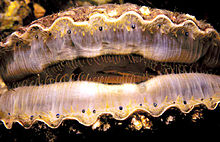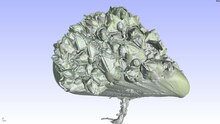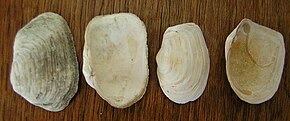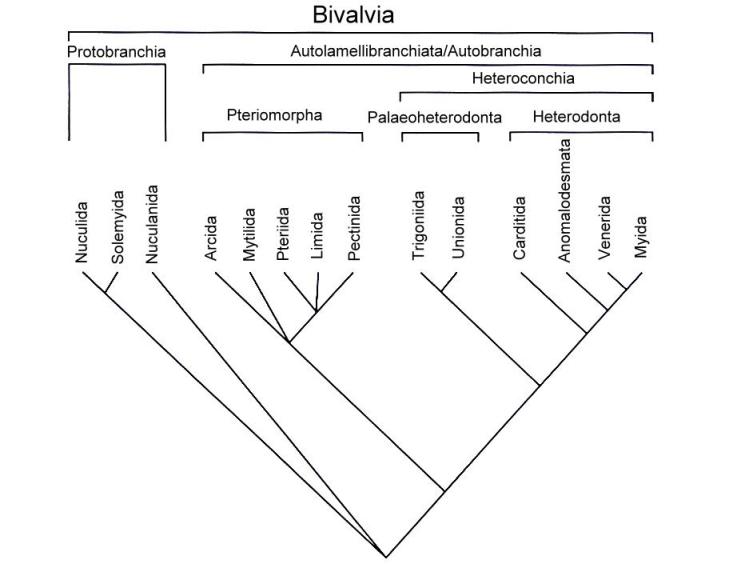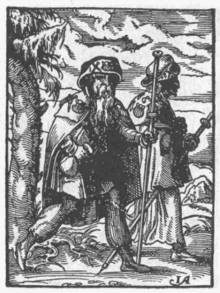Shellfish
| Shellfish | ||||||||||||
|---|---|---|---|---|---|---|---|---|---|---|---|---|

Shells of various types of sea clams |
||||||||||||
| Systematics | ||||||||||||
|
||||||||||||
| Scientific name | ||||||||||||
| Bivalvia | ||||||||||||
| Linnaeus , 1758 |
The mussels ( Bivalvia derived from the Latin word bi-valvius "two-flap") are a class of molluscs (Mollusca). Features of the class are a shell consisting of two chalky flaps and a largely reduced head. They live worldwide in salt water (80 percent), brackish water and fresh water and are mostly found between 0 and 100 m, rarely up to 11,000 m water depth. Mussels live in the sea bed, are attached to it or lie freely on it. Most types of mussels feed on plankton , which they filter out of the water with their gills. Life expectancy ranges from around 1 year to more than 500 years.
Humans use mussels as food and mussel shells as raw material for jewelry, e.g. B. as a pearl supplier , souvenir and earlier also as shell money . In addition, mussels are also used in ponds for cleaning.
The class contains approximately 7,500 to 10,000 recent and 20,000 fossil species , which are divided into 106 families. According to Huber (2010), around 8,000 marine species in four subclasses and 99 families with 1,100 genera can be assumed today . The clam family is the largest marine family with more than 680 species. Another 1200 species in seven additional families are known from freshwater. The river and pond mussels represent the most species-rich family here with around 700 species.
Scientific name
The scientific name "Bivalvia" ( Carl von Linné , 1758) is derived from the two-part calcareous shell that covers your body more or less protectively depending on the species.
The name "Lamellibranchia" Henri Marie Ducrotay de Blainville 1824 was chosen after the design of the gills ( leaf gills ) and is most frequently found in scientific literature. Other primarily historical names are “Pelecypoda” August Goldfuß 1820 after the design of the foot or “Acephale” Georges Cuvier 1798 due to the missing head or “Conchifera” Jean-Baptiste de Lamarck 1818, because of the mussel shells ( shell carriers ).
The terms are not entirely synonymous, problems form the delimitation of the groups. B. "Bivalvia" for Linnaeus also the armpods (brachiopods). The German name shells is used not only in molluscs, but also about for the cancers associated with barnacles .
anatomy
Soft body
With mussels, the head is reduced. The soft body of the mussel is covered on both sides by the mantle lobes and encloses the gills and the mostly separate sex gonads . The circulatory system with a heart is open. Typical muscles are the two separate sphincters that pull the two shell halves together, the foot retraction muscles and the mantle retraction muscles. The foot of the mussels is flexible and equipped with mucous glands. The nervous system has two clusters of nerve cells: the pedal ganglion and the visceral ganglion .
Rudiments of the head
Due to the way of life that originally burrowed in the sediment, the head has receded, with the exception of the mouth region (this is why Frédéric Cuvier called the mussels “Acephala” in 1798, the headless ones). Compared to the other molluscs , the tentacles, the jaws, the radula and the tongue are only rudimentary . The throat glands are largely reduced. Next to the mouth opening are paired flat mouth flaps. In original forms (such as the nut clams ), these mouth flaps still have ciliated buttons that transport food particles to the mouth opening.
coat
The soft body of the mussel is covered and protected on both sides by the mantle flaps. The space formed by the two jacket lobes is called the jacket space.
The mantle edge consists of three folds that perform different tasks: The outermost edge fold forms the shell and shell skin (periostracum), the middle one is used for sensory tasks (e.g. pinpoint eyes) and the inner fold regulates the flow of water into the mantle space to the gills .
The edge of the mantle is light-dark-sensitive in most species. In the case of swimming mussels, such as scallop ( Pecten ) and file mussels ( Lima ), which need more detailed information about their surroundings, the edge of the jacket is covered with simple ocelles (point eyes). The genus Arca can have over 200 eyes.
Originally, the mantle edges run separately and parallel to the shell edge (integripalliat). In most species, the adjacent mantle edges are more or less fused together. Sometimes only three openings remain: two openings at the rear end of the mussel through which respiratory water and food flow into and out of the mantle space - filtered through the gills - and one opening for the foot.
The edge of the mantle around the breathing openings of the mantle is often elongated like a tube in digging or drilling mussel species, so that the mussel is also supplied with water and food in the substrate. The tubular mantle extensions are called siphons . A distinction is made between a supplying sipho (ingestion sipho) and an executing sipho (egestion sipho). Both can be fused into a retractable double tube, which when extended can be longer than the shell itself.
So that this sipho can be pulled back into the shell in case of danger, the line of attachment of the mantle rim muscles had to move inward. This receding approach line can be recognized in the shell by means of a more or less pronounced jacket bay of the jacket line (sinupalliat).
Sand gap mussels ( Mya arenaria ), for example, live buried in the substrate of the Wadden Sea and feed themselves through the Sipho. If they are washed out of the substrate, they must die. In contrast, the common blue mussel ( Mytilus edulis ) sits attached to a solid surface and therefore does not need a siphon. It therefore dies if it is buried by the substrate.
In the edge of the mantle of the giant clams ( Tridacna ) live symbiotic algae (zooxanthellae), which are protected by the clam. In return, the mussel can enjoy the photosynthetic products of the algae.
Gills
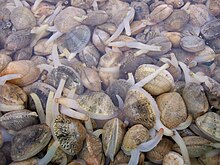
Evolutionarily, the more complex thread and leaf gills for filtration have evolved from simple pinnate gills for breathing. The gills of the mussel located in the shell are not only used for breathing , but in most species also for feeding. The gills are - like the entire mantle cavity - covered with eyelashes , which produce a flow of respiratory water that can also swirl in food particles. The gill arches produce a mucus in which the particles get caught and are transported to the mouth on eyelash bands. Unsuitable particles, however, are not swallowed, but rolled up in mucus to form larger balls of false excrement - pseudofaeces - and released to the outside with the flowing water.
Belt types:
- The paired pinnate gills (ctenidia) each consist of a shaft with several gill leaflets.
- In the filibranchia, W-shaped gill threads hang in two rows in the shell space in front of and behind the foot. The gill threads are attached dorsally to the middle point of the W and the legs of the W are connected to one another by small eyelash structures.
- The net-like pseudo-leaf gills (pseudolamellibranchia) are the result of lateral intergrowth of the gill threads, i.e. connections between successive "Ws".
- The real leaf gills (owl lamellar branches) are characterized by real tissue bridges between the gill threads, permeated by blood vessels.
- The net gills (septibranchia) are narrow, net-shaped and laterally fused with the coat. This intergrowth is muscular. In some forms, the gills sit in rows of holes in these adhesions, which then form a septum, rarely the gills are completely reduced. Typically the netgill species are deep sea dwellers and suck e.g. T. active food.
Circulatory system
Like most molluscs, the blood vessel system of mussels is open. The heart has two antechambers and a main chamber. The main chamber is primarily and secondarily traversed by the rectum.
foot
The originally flat hatchet-shaped foot of the mussels can take on different shapes such as bar-shaped, tongue-shaped or worm-shaped, adapted to the way of life and movement. Floating and stuck mussel species often have largely receded feet. The foot carries the byssus glands , which produce adhesive threads (70% collagen ), especially in young mussels . In some species, the adult animals also produce byssus threads with which the mussels anchor themselves to the ground (e.g. mussels (Mytilidae), ark mussels (Arcidae), scallops (Pectinidae) and pen mussels (Pinnidae)). The byssus connection can later be loosened by the mussel separating the threads secretory ( mytilus ) or pushing them off completely ( pearl oysters ( pinctada )). Mussels also use their byssus threads for defense by invading smaller snails , e.g. B. Spin fish snails ( Hinia ) with it.
casing
The shell of the mussel consists of a right and a left flap and surrounds the soft body of the mussel. Both flaps are held together on the back (i.e. on top) with a lock and a lock strap ( ligament ). The vertebra (umbo) is the oldest part of the clam shell. Colors and shapes are very variable. The shell is formed by the shell, a skin fold of the mussel, in three layers: the colored shell skin ( periostracum ), the prismatic layer (ostracum) and the inner calcareous layer (hypostracum). The two halves can be pulled together by two internal sphincters.
material
The inner shell layers consist mainly of lime , the crystals of which are cemented using an organic substance, conchin . The type of lime structures formed has changed in the course of evolution : the original feature is the formation of pearly aragonite . In today's dominant heterodonts and taxodonts , a cross-lamellar aragonite is formed as a derived feature . At the same time, the Pteriida developed the inclusion of calcite .
Calcite also occurs derived in the middle prism layer, namely in the Anisomyaria and the extinct Hippuritoida . The calcite and aragonite crystals are arranged in the prism layer in small, angular columns ( prisms ) that point more or less vertically outwards.
The outer periostracum consists of organic conchiolin and can vary in shape . Most often a thin skin is formed, but there are also "hairs" (e.g. bearded ark shell ) and lobed curtains (e.g. Solemya togata ).
Ligament
The shell is actually only divided into two halves in the area of the two limestone layers (ostracum and hypostracum). The outermost layer of the shell, the periostracum, also covers the shell here, becomes a ligament and thus connects the two shell halves on the back. This ligament often pulls into the hinge area and thickens into the resilinum (see Resilin and Abductin ). This lock strap consists of non-calcifying conchin . This ligament-resilience complex is very elastic and works antagonistically to the sphincter muscles . After the death of the animal, the two shells therefore gape apart and are easily separated by mechanical stress, such as the surf , so that one usually only finds individual shell halves - in contrast to the rarer doublet, which still consists of both flaps.
lock
So that the two halves do not slip sideways, they usually have so-called lock teeth, the formation of which is also the basis of systematic assignments. These lock teeth consist of tooth-shaped or strip-shaped elevations on the inner back edge of the flaps or corresponding pits on the counter flap, which interlock. Interlocking notches on the lower edge of the shell can prevent it from slipping sideways. These notches are also defining characteristics of a mussel species.
There are up to nine different lock types:
- taxodont ( row-toothed ): numerous teeth are placed in a (usually decreasing) row on the edge of the shell (e.g. in ark clams )
- heterodont ( different teeth): few large teeth and max. four adjoining teeth (e.g. in Cerastoderma , clam )
- demodontal ( ligamentous ): two teeth grown together with a spoon-shaped chondrophor , a protruding support of the inner ligament (e.g. in Mya )
- pachyodont ( thick-toothed ): one to three thick cones that fit into deep pits on the opposite side
- dysodont ( bad teeth): without teeth - only small bumps (e.g. in Ostrea )
- schizodont ( split teeth ): the middle tooth of the left valve is usually split and framed by two wedge-shaped teeth on the right
- isodontic ( same teeth ): two to four teeth symmetrically on both valves
- hemidapedont : weak main teeth, only rarely adjoining teeth
- anomalodesmatic : without or only weakly developed teeth, with a chondrophor, a protruding support of the inner ligament (sphincter cartilage or resilium)
Analogously, the shells of the articulata , which are not mussels, but belong to the arm pods, are called the lock.
Muscle prints
The points of attachment of the sphincter muscles (sphincter muscle impressions) and the mantle retracting muscles (the surface line) play an important role in systematics and determination. Originally two of the sphincter impressions are of the same size ( isomyar ). In the course of evolution, species emerged with differently sized sphincter impressions ( anisomyar or heteromyar ) and those with only one impression ( monomyar ).
The surface line changed from a simple curved line that connects the two sphincter impressions ( integripalliat , see the photo of a cockle) to an indented shape ( sinupalliat , see drawing).
to form
The shells of the individual species are very different in color, shape and texture. White and prickly shells exist as well as elongated, black, and smooth shells.
The shell shape of the mussels is adapted to their respective way of life. Since mussels from different groups often have similar ways of life, for example filtering water through a siphon buried in the sediment, they often develop similar shell shapes ( convergence ) despite being less related . The connection between shell shape and way of life also enables the reconstruction of the way of life of fossil forms and possibly their habitats.
Holes
Seashells washed up on the beach sometimes have circular holes 1–3 mm in size. These are produced by predatory snails (mostly Naticidae ), which pierce the mussel with their rasping tongue and then consume the soft tissues.
Way of life
Habitats
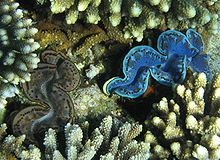
Mussels are tied to life in the water . They occur in salt water , brackish water as well as fresh water , from the Arctic and Antarctic to the tropics . Especially in the Wadden Sea you can find very large amounts of mussels (for example cockles and mussels ) in or on the mudflats . They are an important food for seabirds.
The species Enigmonia aenigmatica (HOLTEN, 1803) (an Anomiidae ) lives in the tide spray on mangrove leaves in the Indo-Pacific and corresponds most closely to a way of life on land.
As adult animals, mussels live mainly sessile (fixed), sometimes on solid surfaces, for example rocks or stones, sometimes in sand or silt. So they belong to the benthos . They are distributed from the intertidal zone to the deep sea.
Movement and anchoring
The following modes of locomotion have been observed in mussels:
- Movement with the help of the foot
- The most common mode of locomotion for mussels is using their feet. In cockles (Cardiidae) , for example, this part of the body can be stretched to three times the length of the shell diameter. Thanks to their feet, mussels can dig themselves in quickly, crawl in jerks or even jump ( gnarled cockles ( Acanthocardia tuberculata ) from a 20 cm high aquarium). The mussels need a suitable substrate for locomotion because, unlike snails, they never have a real creeper. Species of the genus Sphaerium are able to move about like a spanner on plants by stretching out the foot, gluing the tip in place and pulling the body.
- Free swimming over short distances due to the rattle of the bowl
- Species of the Lima genus swim well, as do some of the scallops family (Pectinidae). By jerking the shell halves together, you can generate a directed flow of water and move a little through the water according to the rocket principle . Scallops are said to be able to purposefully expel water through the ears on the sides and thus coordinate their movements more finely , supported by their lens eyes .
- Anchoring with byssus threads
- Some mussels (including blue mussels ( Mytilus ), pen mussels (Pinnidae), ark mussels (Arcidae) and saddle mussel ( Anomia ephippium )) spin so-called byssus threads with a secretion of the byssus gland on their feet , with which they stick to each other and to the base. When changing position, at least mussels can dissolve the byssus with a secretion.
- Fixed anchoring with the shell on the ground
- The best known example are the oysters (Ostreidae). Other firmly established genera: Chama , Pseudochama , some anomia species, spiny oysters ( spondylus ).
- No fixed anchoring as it is protected by the substrate
- Species that drill into substrate such as wood or stone can restrict their mobility and reduce the protective shell. Examples: Shipworms and Krause drilling clams .
nutrition
The mussels were originally sediment eater , derived from filtering plankton eater and special forms such as wood eater , hunter and bacteria breeders .
The primeval mussels from the subclass Protobranchia collect edible particles such as protozoa, eggs, larvae and digestible detritus from the surrounding substrate with elongated mouth lobes. The food then reaches the mouth opening via an eyelash groove.
Most more highly developed mussels feed exclusively by filtering their breath water. Eyelashes located in the jacket space and on the gills generate a directed flow of water that enters through one breathing opening and exits through the other. Solid particles in the respiratory water are caught by the gills and reach the mouth opening in a slime package. The usable particles, mostly plankton , are digested, the rest excreted in strings of manure. Because they are fed by filtration, mussels come into contact with very large amounts of water, which makes them particularly susceptible to pollutants in the water and predestines them as bio-indicators .
The borer clams (Teredinidae) utilize the wood in which they drill with special enzymes.
Some, possibly most of the species of septibranchia belonging to the anomalodesmata (including the club clams ) are hunters who actively suck in small crustaceans with the help of their muscular septum in the mantle cavity .
The giant clams ( Tridacna ) and species of the genus Solemya live with symbiotic, photosynthetic algae in the edge of the mantle, and deep-sea species on black smokers keep sulfide bacteria in special structures in their gills.
Reproduction and development
Most mussel species are sexually separated; there are both male and female animals. Fertilization and subsequent larval development take place externally in the water. The output of eggs and sperm cells in giant clams ( Tridacna ) , for example, can be hormonally coordinated. After developing through a larval stage of the Trochophora or Veliger type, the larva, after a metamorphosis , develops into the juvenile mussel, which, as it grows, looks for a suitable place where it can spend its adult life. In blue mussels ( Mytilus ), oysters ( Ostrea ) and other colony-forming species, the young mussels usually stay close to the colony and then attach themselves not only to the subsurface, but also to other mussels. This is how, for example, the mussel banks of the mussel emerge as we know them from the Wadden Sea .
The mussel species living in freshwater show very different methods of reproduction and development. These mussel groups, as well as the snail groups living in freshwater and on land , have in the course of their development strongly adapted to the changeable living conditions, which differentiate freshwater from the relatively constant conditions in the sea. The group of Unionida, to which the large mussels native to Central Europe ( blue mussels , brook , pond and river pearl mussels ) belong, develops through a parasitic larval stage, the so-called glochidia , which must successfully attach to a fish swimming by for further development .
In contrast, most of the small clams living in freshwater ( pea clams ( Pisidium ) and ball clams ( Sphaerium )) are hermaphroditic animals that give birth to living larvae (ovoviviparia). The three- sided mussel ( Dreissena polymorpha ), on the other hand, develops, like its marine relatives, via a veliger-like plankton larval stage.
Danger
Due to water pollution and river straightening , the large freshwater mussels ( Unionida ), which also includes the freshwater pearl mussel ( Margaritifera margaritifera ), are threatened in many places. Added to this is the further decimation by the muskrat , which was introduced to Eurasia in 1905 and is one of the main predators of these mussel species.
Tribal history and systematics
evolution

Mussels first appeared in fossil form in the Cambrian , around 500 million years ago. The early forms were simply built molluscs with a one-fold shell. In the middle Ordovician , representatives of all modern subclasses appeared for the first time.
The recent mussels are the result of sediment-digging ancestors. As an adaptation to the life in the sea floor, these had reduced the head down to the mouth opening and the mouth lobes. Younger forms switched to a diet through filtration . Evolutionarily , the more complex thread and leaf gills for filtration have evolved from simple pinnate gills for breathing.
During the Cretaceous Period , rapidly growing clams formed reef- like structures that are comparable to today's coral reefs . These mussels, whose shells contained light-conducting elements, sometimes lived in symbiosis with single-cell organisms that operated photosynthesis .
In many rocks, shells are one of the most common fossils because the hard shell is well preserved. Therefore they often serve as reference fossils .
The evolution rate of the mussels is very different. While species that serve as index fossils exist on average for 0.3 to 1 million years, individual genera are considerably longer lived. The genus Gryphaea has been recorded since the Lower Jurassic (195 million years), the genus Spondylus since the Permian (285 million years) and Lima since the Jurassic .
The original, taxodontic lock of the mussels has a large number of small, uniform teeth, while highly derived, heterodontic forms consist of a few main teeth and up to four ridge-shaped posterior teeth or have no teeth at all.
Systematics of the large groups
The system of mussels has been subject to major changes in the past. Even today, new data are being added, primarily through molecular genetic studies, which could even slightly change the large systematics. However, the systematics and the phylogeny of the large groups have largely stabilized in the last 15 years - with a few exceptions. The differences in the various classifications are primarily based on the very subjective hierarchical position of a few groups (e.g. order Ostreida versus superfamily Ostreoidea, anomalodesmata order or superordinate order).
The classification of mussels according to Bieler & Mikkelsen (2006) (only recent groups) and Amler et al. (2000) (also fossil groups) as well as according to the Zoological Record is currently as follows:
Class Bivalvia Linnaeus , 1758
- Infraklasse Protobranchi (at) a Pelseneer , 1889
- Order Nuculida Dall , 1889
- Order Solemyida Dall , 1889
- Order Nuculanida Carter, Campbell & Campbell, 2000 (this new order has not yet found general acceptance (according to the Zoological Record); alternatively, the families united in this order can be placed in the order Nuculida)
- Infraclass Autolamellibranchi (at) a / Autobranchi (at) a Grobben , 1894
- Subclass Pteriomorphia Beurlen , 1944
- Order † Praecardioida Newell , 1965
- Order † Cyrtodontoida Scarlato & Starobogatov, 1971
- (Order Ostreida Férussac , 1822) (this order is not recognized by Bieler & Mikkelsen (2006), but "degraded" to a superfamily within the order Pteriida. In contrast, the overwhelming majority of malacologists use this large group in order; according to the Zoological Record)
- Order Arcida Stoliczka , 1870
- Order Mytilida Férussac , 1822
- Order Pteriida Newell , 1965
- Order Limida Waller , 1978
- Order Pectinida H. Adams & A. Adams , 1857
- Subclass Heteroconchia Hertwig , 1895
- Paragraph Palaeoheterodonta Newell , 1965
- Order † Actinodontoida Douvillé , 1912
- Order † Modiomorphoida Newell , 1969
- Order Trigonoida Dall , 1889
- Order Unionida Stoliczka , 1870
- Superordinate Heterodonta Neumayr , 1883
- Order Carditida Dall , 1889
- Order † Hippuritida Newell , 1965
- Order Venerida H. Adams & A. Adams , 1856
- Order Myida Stoliczka , 1870
- Order Anomalodesmata Dall , 1889 (This group is still regarded by most malacologists as a superordinate group; Harper et al. (2006) justify the downgrading to ordinal rank, however, with many new molecular genetic data).
- Paragraph Palaeoheterodonta Newell , 1965
- Subclass Pteriomorphia Beurlen , 1944
For even older classifications, which occasionally appear in popular scientific mussel manuals, refer to the article Systematics of mussels .
family tree
There is broad agreement among malacologists about the phylogeny or cladistics of today's groups insofar as the Protobranchi (at) a are regarded as the sister group of the remaining mussels, the Autolamellibranchi (at) a (or Autobranchi (at) a). However, some consider the Protobranchia to be a paraphyletic grouping. Within the autolamellibranchia, Pteriomorphia and Heteroconchia in turn form sister groups. The further subdivision of sister groups within the pteriomorphia is still uncertain. Within the heteroconchia, palaeoheterodonta and heterodonta form sister groups.
Number of species according to large groups
Huber (2010) assumes there are 106 families worldwide with a total of 1260 genera and about 9200 recent species of mussels. These are distributed among the respective groups as follows:
| number of | Familys | Genera | species |
|---|---|---|---|
| Protobranchia | 10 | 49 | 700 |
| Nuculoidea | 1 | 8th | 170 |
| Sapretoidea | 1 | approx. 5 | 10 |
| Solemyoidea | 1 | 2 | 30th |
| Manzanelloidea | 1 | 2 | 20th |
| Nuculanoidea | 6th | 32 | 460 |
| Pteriomorpha | 25th | 240 (including 2 freshwater) | 2000 (including 11 freshwater) |
| Mytiloidea | 1 | 50 (1 fresh water) | 400 (5 fresh water) |
| Arcoidea | 7th | 60 (1 fresh water) | 570 (6 freshwater) |
| Pinnoidea | 1 | 3 (+) | 50 |
| Pterioidea | 5 | 9 | 80 |
| Ostreoidea | 2 | 23 | 80 |
| Dimyoidea | 1 | 3 | 15th |
| Anomioidea | 2 | 9 | 30th |
| Plicatuloidea | 1 | 1 | 20th |
| Pectinoidea | 4th | 68 | 500 |
| Limoidea | 1 | 8th | 250 |
| Palaeoheterodonta | 7 (including 6 freshwater) | 171 (of which 170 freshwater) | 908 (including 900 freshwater) |
| Trigonioidea | 1 | 1 | 8th |
| Unionoidea | (6 fresh water) | (170 freshwater) | (900 freshwater) |
| Heterodonta | 64 (including 1 freshwater) | 800 (including 16 freshwater) | 5600 (including 270 fresh water) |
| Crassatelloidea | 5 | 65 | 420 |
| Thyasiroid | 1 | approx. 12 | about 100 |
| Lucinoidea | 2 | approx. 85 | about 500 |
| Galeommatoidea | approx 4 | about 100 | about 500 |
| Cyamioidea | 3 | 22nd | 140 |
| Solenoidea | 2 | 17 (2 freshwater) | 130 (4 freshwater) |
| Hiatelloidea | 1 | 5 | 25th |
| Gastrochaenoidea | 1 | 7th | 30th |
| Chamoidea | 1 | 6th | 70 |
| Cardioidea | 2 | 38 | 260 |
| Tellinoidea | 5 | 110 (2 freshwater) | 900 (15 freshwater) |
| Glossoidea | 2 | 20th | 110 |
| Arcticoidea | 2 | 6th | 13 |
| Cyrenoidea | 1 | 6 (3 fresh water) | 60 (30 freshwater) |
| Sphaerioidea | (1 fresh water) | (5 fresh water) | (200 freshwater) |
| Veneroidea | 4th | 104 | 750 |
| Hemidonacoidea | 1 | 1 | 6th |
| Cyrenoidea | 1 | 1 | 6th |
| Ungulinoidea | 1 | 16 | 100 |
| Mactroidea | 4th | 46 | 220 |
| Dreissenoidea | 1 | 3 (2 fresh water) | 20 (12 freshwater) |
| Myoidea | 3 | 15 (1 fresh water) | 130 (1 fresh water) |
| Pholadoidea | 2 | 34 (1 fresh water) | 200 (3 freshwater) |
| Limoidea | 1 | 8th | 250 |
| ( Anomalodesmata ) | (14) | (71) | (770) |
| Pholadomyoidea | 2 | 3 | 20th |
| Clavagelloidea | 1 | 2 | 20th |
| Pandoroidea | 7th | 30th | 250 |
| Verticordioidea | 2 | 16 | 160 |
| Cuspidarioidea | 2 | 20th | 320 |
Mussels and man
Mussels as food
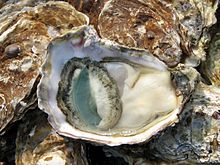

People from many historical and prehistoric cultures have left indications in their kitchen waste that clams were consumed. The oldest evidence for this is around 165,000 years old and comes from the so-called Pinnacle Point people from South Africa . In Denmark, such prehistoric clam heaps are called Køkkenmøddinger .
Even today, many types of mussels - in the western world particularly mussels , oysters , clams , razor clams (such as sword- shaped clams ) and scallops - serve as human food. In Europe alone, around 100,000 tons of mussels are consumed every year. The breeding of mussels on mussel banks is today (especially oysters and mussels, which naturally also form such banks) an important trade on almost all coasts of the world.
The information on nutritional value differs only slightly between mussel species. The energy content in kJ was calculated according to the formulas valid for humans. If mussels are used as food for animals, the effort involved in digesting the mussel shell may have to be considered. Depending on the thickness of the shell, the energy balance can therefore be negative.
| Energy content and nutrients per 100 g in g (not fried) (edible portion for fresh produce) |
||||
|---|---|---|---|---|
| Art | kJ | protein | fat | Carbohydrates |
| Scallop | 336 | 11.9 | 1 | 5.5 |
| Clam | 288 | 11.1 | 1.4 | 2.6 |
| Mussel | 292 | 10.2 | 1.5 | 3.4 |
| Clam | 340 | 11.1 | 1.1 | 6.4 |
Pearls and mother-of-pearl
In addition to their use as food, the use of shell parts, especially pearls and mother-of-pearl , as jewelry is important. This also has a long tradition. For example, in the Neolithic in Europe, mussel shells were transported over long distances as commodities, as finds of the shells of the prickly oyster ( Spondylus gaederopus ) in the Bandkeramischen and Tisza cultures show. Spondylus princeps , which occurs on the coast of Ecuador , was of great importance to the people of the pre-Columbian period. The finds of the Asian Mehrgarh culture of the earliest Neolithic also include jewelry made from sea shells.
Representatives of the Unionida and Pteriidae have always been natural sources for pearls and mother-of-pearl. The high value of pearl mussel pearls meant that they were placed under protection in some regions of today's Federal Republic of Germany in the Middle Ages and poaching was severely punished, for example by chopping off the hand. From the 5th century AD. Chr. Were in China so-called "Buddha beads" in freshwater mussels (such. As Hyriopsis cumingii bred), but only the Japanese Kokichi Mikimoto succeeded in the early 1920s, the first full round cultured pearls on the market and thus lay the foundation of today's pearl cultivation and trading in pearls.
Shell currencies
Many cultures, such as the natives of North America , had their own shell currency , as shellfish were valued for their rarity and their jewelry value. This is how the English term “shell out” for “pay” was born.
Damage from the shipworm
The negative effects of mussels on humans and their technology are also known. An example of bioerosion is the shipworm ( Teredo navalis ), which feeds on the wood of ships, jetties, groynes or wooden dyke gates and makes the wood brittle through its long corridors. Its introduction from America led to a revolution in shipbuilding , its current penetration into the Baltic Sea is a current problem of underwater archeology , as it is destroying historically significant remains of wooden ships there.
Symbols and mythology
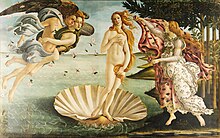
Shells are found as a symbol in art and mythology, which in turn inspired the naming of shells. For example, the clams (which also includes the clam genus Venus ) are named for Venus , the ancient Roman goddess of love, erotic desire and beauty. Depictions often show the birth of Venus from a shell; however, a clam is often not shown, but a scallop of the genus Pecten (also in the picture on the right).
Since the Middle Ages, the more curved right shell halves of the Great scallop serve Pecten maximus (or Zinnabgüsse such shells) the Jacob pilgrims that the grave of St. James in Santiago de Compostela visit as a badge. The Mediterranean pilgrim mussel Pecten jacobaeus , which comes closer to the name “scallop”, cannot be the species used by pilgrims due to its range of distribution. In the article scallop both Pecten maximus and Pecten jacobaeus are therefore referred to as scallops.
The coat of arms of Guinea-Bissaus contains a stylized scallop as a symbol of the country's location on the coast of Africa. The oil company Shell (English shell = mussel) uses it as a company logo.
The "sound of the sea" in the shell
It is said that the sound of the sea can be heard in shells. You can record the noise of the shell with a microphone without a person being nearby. The noise would then be heard on the recording.
In fact, this is a resonance phenomenon: As in a wind instrument, there is a column of air in the shell that has a certain natural frequency. This is the sound that arises when you make the shell vibrate. The air column is set in motion by barely noticeable noises in the environment, the frequencies of which correspond approximately to the natural frequency of the mussel. This significantly amplifies these otherwise inaudible ambient noises. The resulting mixture of sounds is perceived by humans as noise.
See also
- Conch shell
- Shell Museum
- Køkkenmøddinger (prehistoric clam heaps)
literature
- R. Tucker Abbott, S. Peter Dance: Compendium of Seashells . 1990, ISBN 0-915826-17-8
- Markus Huber: Compendium of Bivalves. A Full-Color Guide to 3'300 of the World's Marine Bivalves. A Status on Bivalvia after 250 Years of Research . 901 pp. + CD. ConchBooks, Hackenheim 2010, ISBN 978-3-939767-28-2
- Rudolf Kilias: Marine mussels and snails , lexicon. 2nd edition, Ulmer, Stuttgart 2000 (first edition 1997), ISBN 978-3-8001-3105-1
- Gert Lindner: Shells and snails of the oceans , appearance, occurrence, systematics [identification book], 5th, revised and expanded edition. BLV, Munich / Vienna / Zurich 1999, ISBN 3-405-15438-3
- Gert Lindner: Collecting mussels and snails and determining : the most common and most beautiful species. For the beaches of Europe [destination book], In: The reliable nature guide . 3rd edition, BLV, Munich 2008, ISBN 978-3-8354-0374-1
- Arno Hermann Müller : Textbook of paleozoology . Tape. II, part 1, Protozoa - Mollusca 1 , Fischer , Jena 1993, ISBN 3-334-60409-8
- Alfred Kaestner (founder): Textbook of special zoology. Volume I, Part 3 Mollusca etc. , Fischer , Stuttgart 1982, ISBN 3-437-20260-X
- Rüdiger Bieler, Paula M. Mikkelsen: Bivalvia - a look at the branches . Zoological Journal of the Linnean Society, 148: 223-235, London 2006.
- Michael Amler, Rudolf Fischer, Nicole Rogalla: mussels . Haeckel library, Volume 5. Enke Verlag, Stuttgart 2000, ISBN 3-13-118391-8
- Elisabeth M. Harper, Hermann Dreyer, Gerhard Steiner: Reconstructing the Anomalodesmata (Mollusca: Bivalvia): morphology and molecules . Zoological Journal of the Linnean Society, 148 (3): 395-420, London 2006
- DC Campbell: Paleontological and molecular evidence on Bivalve phylogeny . In: Evolutionary Paleobiology and Paleoecology of the Bivalvia 2002
- JA Schneider: Bivalve systematics in the 20th century . Journal of Paleontology, 75: 1119-1127 2001.
- Gonzalo Giribet, Daniel L. Distel: Bivalve phylogeny and molecular data. In: Lydeard, Charles; Lindberg, David R. [Eds]. Molecular systematics and phylogeography of mollusks. pp. 45-90. [Smithsonian Series in Comparative Evolutionary Biology.]. Smithsonian Books, Washington and London 2003.
- Robert Prezant: Classification . In: PL Beesley, GJB Ross & A. Wells (eds.): Mollusca. The Southern Synthesis, Part A Fauna of Australia , vol. 5 , pp. 224-226, Collingwood, CSIRO Publishing, 1998
- JG Carter, DC Campbell, MR Campbell: Cladistic perspectives of early bivalve evolution . In: Geological Society Special Publications, pp. 47-79, Geological Society, London 2000.
- Norman D. Newell : Classification of Bivalvia. In: RC Moore (Ed.): Treatise on Invertebrate Paleontology, Part N, Mollusca 6 , pp. N205-N218, University of Kansas Press, Lawrence, Kansas 1969.
- Literary representation
- Birgit Vanderbeke : Eating mussels [narration]. Fischer-Taschenbuch 13783 , Frankfurt am Main 1997 (first edition: Rotbuch, Berlin 1990, ISBN 3-88022-757-8 ), ISBN 978-3-596-13783-1 (Ingeborg Bachmann Prize 1990).
Web links
- Mussels on weichtiere.at
- http://www.bivalvia.net
- www.wissenschaft.de: Why the disappearance of the sharks threatens the mussels - researchers show the connection between the decline in shark and mussel populations
Individual evidence
- ^ Pia Andrea Egger: Anatomical-histological examination of the gill retractors in selected species of the caudofoveata (Mollusca). (PDF) Diss. University of Vienna, 2008.
- ↑ Wolfgang von Buddenbrook: Comparative Physiology . Volume III: Diet, water balance and mineral balance of animals . Springer Basel 1956, p. 262
- ↑ 121 - Acoustic cavity vibrations. (No longer available online.) Friedrich Schiller University Jena, Faculty of Physics and Astronomy, August 13, 2010, archived from the original on May 13, 2012 ; accessed on October 19, 2011 (experiment with an empty bottle).
- ↑ Vladimir Rydl: Knowledge question. The sound of the sea or ringing in the ears - what do you hear when you hold the shell of a sea snail to your ear? In: Planet Knowledge. June 1, 2009, accessed October 19, 2011 .
- ↑ What is rustling in the shell? (No longer available online.) Swiss television, April 19, 2007, formerly in the original ; Retrieved October 19, 2011 . ( Page no longer available , search in web archives )

